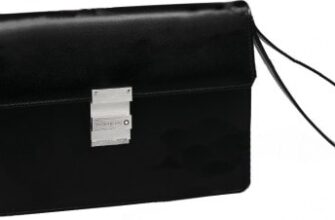Have you ever wondered why men wear ties? Why do you need a strip of fabric around the neck, used as a decoration? Obviously, a tie is a decorative accessory; it does not warm us in the fierce winter and does not cool us in the hot summer. However, a lot of people, myself included, wear ties almost every day.
Wanting to understand what the history of the origin of the tie was, we will consider several stages of the evolution of this accessory, from the first mentions to the present day.
The name 'tie' in Russian comes from the words 'Haisdoek' and 'Haistuch', of Dutch and German origin, respectively. The literal translation is 'neckerchief'. For a more visual evolutionary development, let's do something like a historical timeline.
| Period | Important events |
| First mention. Around 220 BC | The first mention, as well as evidence of the origin of the tie, can be found in ancient China. The first emperor of the Qin Shihuang-di empire ordered the creation of an army that would protect him after death. His terracotta army in the tomb was discovered in 1974. On the necks of replicas of people – nobles and warriors, scraps of fabric were tied, resembling ties. 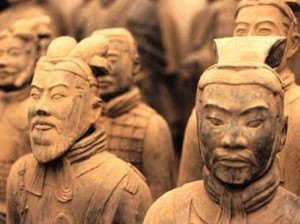 |
| A.D. 113 | 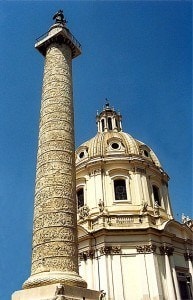 This year, after the victorious war of the Roman legion during the reign of Emperor Trajan, a white carved column was erected. It depicted legionnaires with a bandage around their neck, which was tied in a knot. The history of the tie begins from these times. This year, after the victorious war of the Roman legion during the reign of Emperor Trajan, a white carved column was erected. It depicted legionnaires with a bandage around their neck, which was tied in a knot. The history of the tie begins from these times. |
| XVII century (1650) | 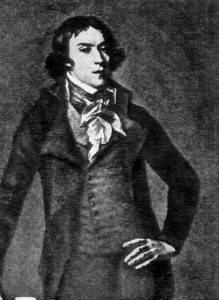 During the 30-year war in France, King Louis XIV invited after victorious Croatian officers who wore armbands in the form of a tie on their uniforms. The king liked this accessory so much that he ordered to wear a tie at all royal meetings, although then it was called 'La Cravat' in translation 'Croat'. This name has survived in French to this day. During the 30-year war in France, King Louis XIV invited after victorious Croatian officers who wore armbands in the form of a tie on their uniforms. The king liked this accessory so much that he ordered to wear a tie at all royal meetings, although then it was called 'La Cravat' in translation 'Croat'. This name has survived in French to this day. |
| XVIII century | The neckerchief with elongated ends began to be called the familiar name “tie”. In Russia, during the reign of Peter I, ties became very common. Peter, with his innovative vision, issued decrees forcing the wearing of a tie. It must be said that along with the decree on shaving the beard, the boyars also disliked the decree on wearing a tie, because it did not fit any traditional outfit, could not be used to wipe the nose. A handkerchief, by the way, was also a curiosity for a resident of that time, so the upper classes had a confusion about which handkerchief to do. A special decree was even issued: “It’s worthless to wipe off with a tie, and you are not ordered to blow your nose into it. They did not like the tie, so they gave it different nicknames, for example, a noose or snake. |
| 19th century | 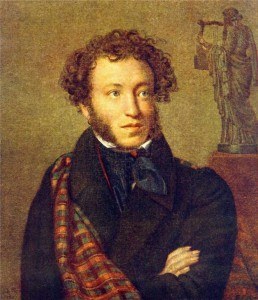 The tie becomes more and more similar to the modern one, undergoing many changes. Lord Byron became a trendsetter during this period and instilled a love for a loosely knotted and non-tightening tie. He was nicknamed 'ala Byron'. By the way, our Alexander Pushkin loved to wear ties. The tie becomes more and more similar to the modern one, undergoing many changes. Lord Byron became a trendsetter during this period and instilled a love for a loosely knotted and non-tightening tie. He was nicknamed 'ala Byron'. By the way, our Alexander Pushkin loved to wear ties. |
| 1827 year | 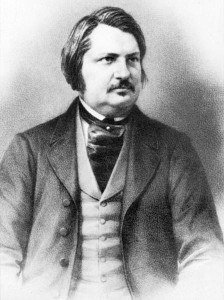 The famous French writer Honore de Balzac publishes the book The Art of Wearing a Tie. He tells us not only about the need to wear a tie, but also describes the varieties of scarves for the neck. Among the descriptions there are such ties as 'Byronovka', 'Tragic', 'Walter Scott' – a tie made of fabric in a cage. The white tie was recommended to be used exclusively with a tuxedo or tailcoat. Balzac owns the famous saying: – 'A man is worth the same as his tie.' The famous French writer Honore de Balzac publishes the book The Art of Wearing a Tie. He tells us not only about the need to wear a tie, but also describes the varieties of scarves for the neck. Among the descriptions there are such ties as 'Byronovka', 'Tragic', 'Walter Scott' – a tie made of fabric in a cage. The white tie was recommended to be used exclusively with a tuxedo or tailcoat. Balzac owns the famous saying: – 'A man is worth the same as his tie.' |
| 1900 – 1909 | The tie has become a must-have accessory for business etiquette. The most common neckerchiefs, similar to the 'Croatian' ones, were tied in a knot. At that time, at least 100 types of nodes were known. For example, the 'Quarter' knot was invented at this particular time; by the way, it remains one of the most popular to this day. During the same period, men begin to use bow ties for evening wear, as well as at special events. 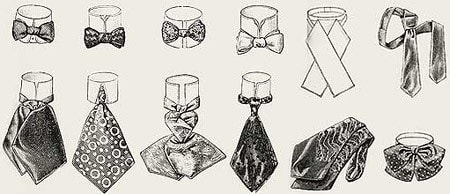 |
| 1910 – 1919 | There has been a change in attitude towards the tie. They began to produce not only for formal wear, but also for everyday, informal. |
| 1920 – 1929 | 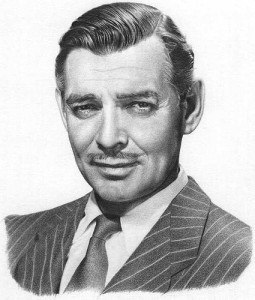 The end of the era of scarf neck ties. American businessman Jesse Langsdorf files for a patent that mentions “the perfect tie.” Everything is white in a special technology for cutting the fabric for a tie, consisting of 3 parts. This allowed the tie to maintain its shape after being tied and worn for a long time. During this period, new varieties of tie knots began to appear. The end of the era of scarf neck ties. American businessman Jesse Langsdorf files for a patent that mentions “the perfect tie.” Everything is white in a special technology for cutting the fabric for a tie, consisting of 3 parts. This allowed the tie to maintain its shape after being tied and worn for a long time. During this period, new varieties of tie knots began to appear. |
| 1930 – 1939 | In this decade, ties began to develop and acquire various models, using bold decisions in the texture of the fabric, color and length. It was during this period that the famous Windsor knot appeared. In the USSR, the pioneer red tie was worn. The tie was a three-end scarf, as a symbol of the inviolability of the connection between generations: communists, Komsomol members and pioneers.  |
| 1940 – 1949 | The period of the Second World War. The evolution of the tie has stalled because people had more important things than formal ties. Nevertheless, after the end of the war, fashionable ties with half-naked girls began to appear in the United States. |
| 1950 – 1959 |  In the 50s, a thin tie appeared, designed to emphasize the strict suits of that time. This is the time to experiment with materials and colors. In the 50s, a thin tie appeared, designed to emphasize the strict suits of that time. This is the time to experiment with materials and colors. |
| 1960 – 1969 | Having played enough with fashion in the 50s, in the 60s wide ties became very common under the name 'Kipper Tie' with a width of about 10 cm or more, as well as very narrow, like a strip. |
| 1970 – 1979 | In the days of rock and roll and disco, wide ties, but in brighter colors, were still popular. For example, the British band “The beatles ” performed in “rebellious” tight ties.  |
| 1980 – 1989 | In the 80s, fashion did not change much, wide ties were in the 'trend', but extravagant options appeared in the form of thin leather ties. |
| 1990 – 1999 | The fashion for wide ties is gradually disappearing, and in everyday life, ties with a width of 9.5 cm are increasingly common. Patterns, monograms and prints with 'cucumbers' are very popular.In the late 90s, scientists from Cambridge University – Thomas Fink and Yong Mao mathematically calculated, that tying a tie is possible with only 85 different variations. Some time later, also a mathematician from Sweden – Mikael Veidemo-Johansson from the Institute in Stockholm, after watching the famous film 'The Matrix', noticed that the tie knot of one of the heroes – Merovingen, is not in the works described by Thomas and Jong.  Together with his colleagues, Mikael calculated mathematically that there are still 177,147 knot options, but some are either not attractive or require a tie that is too long. By the way, here is a link to a site where tie corners are randomly generated. Together with his colleagues, Mikael calculated mathematically that there are still 177,147 knot options, but some are either not attractive or require a tie that is too long. By the way, here is a link to a site where tie corners are randomly generated. |
| 2000 – 2009 | The tie is getting narrower, now it is fashionable to wear 9 cm ties (in width). In Europe, compared to America, they are even thinner – 8 cm. In 2008, the famous incident with Saakashvili's tie occurred. The BBC channel accidentally showed footage of Georgian President Mikheil Saakashvili chewing his tie.  The incident became an element of propaganda in the information war around South Ossetia. The incident became an element of propaganda in the information war around South Ossetia. |
| 2010 – today | Today, the market offers ties of various thicknesses, widths, fabric compositions, colors and patterns. For the most part, ties with a width of 3.25-3.5 inches (8.26 – 8.89 cm) are widespread. Knitted ties that are not made from traditional fabrics have become popular.  Evolution continues … Evolution continues … |
To create a post, materials from Wikipedia were used.









